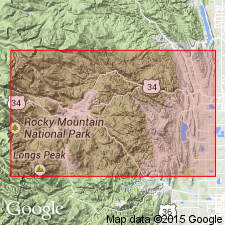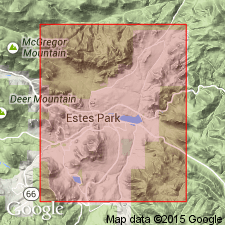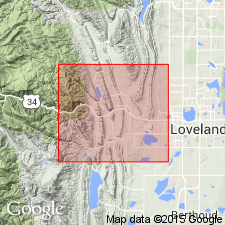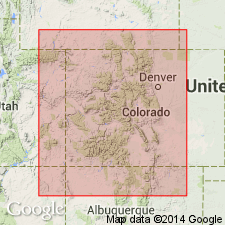
- Usage in publication:
-
- Big Thompson schist
- Modifications:
-
- Original reference
- Dominant lithology:
-
- Schist
- AAPG geologic province:
-
- Southern Rocky Mountain region
Summary:
Pg. 51-63. Big Thompson schist. A series of metamorphosed sandstones, shales, and limestones with a small amount of conglomerate. The strata are a series of interbedded metamorphosed crystalline rocks derived by regional and contact metamorphism against granites which cut through the schists in stocks, bathyliths, and numerous dikes. There is a definite regular gradation of Big Thompson schists from the highly metamorphosed, dense black biotite-sillimanite schists of the Continental Divide and Estes Park region eastward through quartz-biotite and chlorite schists to pure quartz schists in Loveland Canyon. All the diverse phases are interbedded, show transition varieties, and, although clearly graded from west to east, are undoubtedly parts of same formation. In general the schistosity is parallel to original bedding of the sediments. Age is pre-Cambrian.
Named from Big Thompson River, which, in traversing eastern slope of Front Range, has exposed a complete section of the schist, Larimer Co., central northern CO.
Source: US geologic names lexicon (USGS Bull. 896, p. 188).

- Usage in publication:
-
- Big Thompson series
- Modifications:
-
- Revised
- AAPG geologic province:
-
- Southern Rocky Mountain region
Summary:
Estes Park beds (new) of Big Thompson series of metasedimentary formations and Longs Peak (Silver Plume) and Mount Olympus granitic rocks constitute bedrock of Estes Park Valley. [Age is Precambrian.]
Source: US geologic names lexicon (USGS Bull. 1200, p. 342).

- Usage in publication:
-
- Big Thompson metasediments
- Modifications:
-
- Areal extent
- AAPG geologic province:
-
- Southern Rocky Mountain region
Summary:
Big Thompson metasediments. Oldest rocks in area near mouth of Big Thompson Canyon. Quartzite, micaceous quartzite, feldspathic quartzite, quartz schist, and mica schist interbedded in a relatively undeformed sequence at least 13,000 feet thick. [Age is Precambrian.]
Source: US geologic names lexicon (USGS Bull. 1200, p. 342).

- Usage in publication:
-
- Big Thompson Schist†
- Modifications:
-
- Abandoned
- AAPG geologic province:
-
- Southern Rocky Mountain region
Summary:
Pg. D4 (table 1). †Big Thompson Schist. An obsolete name not used in its type area [Big Thompson River, Larimer Co., central northern CO] in recent decades.
(See Braddock and others, 1970, USGS Geol. Quad. Map GQ-829).
Source: Publication.
For more information, please contact Nancy Stamm, Geologic Names Committee Secretary.
Asterisk (*) indicates published by U.S. Geological Survey authors.
"No current usage" (†) implies that a name has been abandoned or has fallen into disuse. Former usage and, if known, replacement name given in parentheses ( ).
Slash (/) indicates name conflicts with nomenclatural guidelines (CSN, 1933; ACSN, 1961, 1970; NACSN, 1983, 2005, 2021). May be explained within brackets ([ ]).

